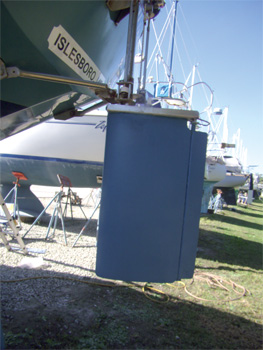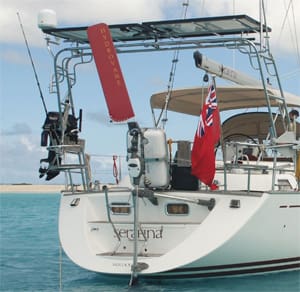To the editor: Many sailors who make short-handed, offshore passages — we have a two-person crew — love the notion of electric-energy-free wind vane self-steering. We’re not purists; we appreciate what modern electrics do for sailors; no question, they make the passages safer and more enjoyable. However, if at sea somehow the autopilot quits or the battery charging system fails resulting in no power to the autopilot, the crew has no choice except to hand steer the boat.
We’ve owned a Ratcliffe wind vane self-steerer for more than 25 years. It is installed on our Tartan 34 Endeavour. We’ve learned a few things that might be helpful for those sailors who wish to make less stressful passages. We have a solar panel and a Honda 2000 generator to charge batteries for all our onboard electrics including the autopilot. Never the less, we always rely on the wind vane offshore.
A tour of most saltwater boatyards which cater to sailboats, reveals that about 5 percent of the boats have some sort of self-steering gear installed. I’ve noted only one or two Ratcliffe auxiliary rudders in the last 20 years. More common are Monitor and Aries and other brands of self-steerers. I love to talk with the owners because they usually are serious passagemakers. When under sail we all prefer using the wind vane rather than an autopilot. It uses no electricity, it’s quiet and extraordinarily reliable. And, we believe, steers the boat on all points of sail better than an autopilot. Wind vane self-steerers do require five knots or more of wind across the deck to work properly. When the wind drops below that, we resort to our autopilot. Wind vane steering attachments are available for most autopilots, but in light air they are no better than wind driven self-steering gear.
 |
|
Dick de Grasse |
|
The author’s Ratcliffe auxiliary rudder self-steering model has a trailing edge trim tab. |
There are several types of wind vane self-steerers. They usually mount on the transom; which, of course, could interfere with transom-mounted dinghy davits. Most Aries, Monitor, Norvane, Cape Horn, Fleming, Hasler and others have paddles in the water driven by a wind vane that is adjusted to the apparent wind, sail trim and course. The output of the paddle usually drives a tiller or wheel through a series of lines and blocks. Wind vanes work best on tiller boats because there is no slack inherent in wheel-driven boats. And, I would suspect, it is more efficient to rig a self-steerer to a tiller than a drum on a wheel. Most wind vanes can, however, be rigged to drive the main helm through a series of blocks and rope coil around a drum mounted on the wheel. Control line chafe can be a problem with all self-steerers driving either a wheel or a tiller.
Wind vanes are used by many short-handed sailors for both coastal cruising and offshore passagemaking. Paddles are usually pulled up out of the water and air vanes removed when motoring or at anchor. My survey of nearly 300 mostly sailboats in Boot Key Harbor, Marathon, Fla., noted that the handful of wind vane self-steerers are mounted on short-handed boats less than 40 feet. Larger boats mostly use autopilots. Two boats moored nearby have installed Monitor self-steerers: one rigged to a tiller on a Westsail 32 a second connected to a drum on the wheel of a Cape Dory 36. Both owners claimed to engage the wind vane immediately after leaving the breakwater on nearly every passage.
Some sailors have rigged their electric autopilot to provide the course and trim instructions to a self-steering rudder instead of a wind vane. The result is much less autopilot current draw since the wind vane rudder does the tiller or wheel steering as usual. The autopilot simply provides the course corrections.
There are also auxiliary rudder type units like Hydrovane. With this approach, the main rudder is locked off and the Hydrovane rudder steers the boat after the wind vane is set to the correct angle. At least two designs, Ratcliffe and RVG, are auxiliary rudders with trim-tabs. Only the trim-tab is moved by the wind vane. A quick review of trim-tabs shows how effective they can be. A picture of our Ratcliffe shows how small the trim-tab is relative to the self-steering rudder and the main rudder. Trim-tabs have an extraordinary mechanical advantage. Auxiliary rudders have an important feature that should be considered by anyone planning to purchase wind vane self-steering gear particularly for accident-prone spade rudder boats; an auxiliary rudder can effectively steer the boat in the event of a main rudder failure. This means that when the boat is sailing under control of the auxiliary rudder, the main rudder is locked amidships. In this configuration the keel is effectively extended by the length of the main rudder — an extraordinary benefit in a big following sea or when pinching up. The only time we have ever had to help our Ratcliffe — we affectionately call him Wally — was in the narrow passage between Grand Canaria and Tenerife in the Canary Islands. The following seas were huge! Even then Wally steered the boat, I had only to tweak the main rudder occasionally.
Auxiliary rudder gear is usually left in the water all the time with the vane in the locked and stowed position; the boat can be driven forward and back with no difficulty. We lose less than half a knot leaving the auxiliary rudder in the water; a price we pay for having it available for inshore sailing as well as passagemaking. Only a few of the self-steering gear I’ve seen are of the auxiliary rudder type.
The cost of self-steering gear varies from $1,000 for used gear up to $5,000 for new equipment, not including installation. Most self-steering gear is highly reliable and lasts for years. I would purchase and install gear with a proven offshore record. Anyone considering used gear should know that it will be necessary to fit the brackets to the transom angle of the boat so that the gear is vertical with respect to the water. Sometimes this is easy, sometimes it requires changing the length and design of the brackets. The Internet is one source to obtain information about any particular manufacturer. Auxiliary rudder gear is usually more expensive because there is more equipment involved.
Possibly the most important decision short-handed passagemaking sailors can make is steering: autopilot, wind vane, or a combination of the two, given the boat’s rudder design (spade or skeg rudder) and tiller versus wheel. A steering failure at sea with a short-handed crew is perhaps the most serious problem one can have.
—————
Richard de Grasse is a commodore of the Seven Seas Cruising Association and, along with his wife Kathy, owns the Tartan 34 Endeavour.

